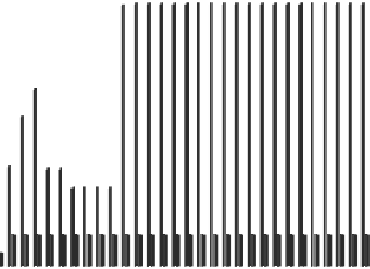Agriculture Reference
In-Depth Information
11.5
Results of the Financial Analysis
Figure 11.1 indicates that multistrata agroforestry is much more profitable than
seasonal culture, even in the year of establishment.
1
Including family labor cost
shadow-priced at $1 day
−1
(see previous section), the minimum income per hectare
per year of multistrata agroforestry is US$2,375 and the maximum is US$10,818.
On the other hand, the minimum income of seasonal culture is US$565 and the
maximum is US$1,319 per hectare per year.
2
Multistrata Agroforestry
Monoculture
12000
10000
8000
6000
4000
2000
0
22
1
4
7
10
13
16
19
25
28
Year
Fig. 11.1
Net returns (in US$ ha
-1
) of multistrata agroforestry and seasonal monoculture in
Rajshahi district of northern Bangladesh (Field data)
1
Some risk factors such as floods, droughts, and insects are excluded.
2
These incomes may be compared with those of (social forestry) plantations producing forestry
products such as timber, firewood, and poles. Muhammed et al. (2005) supply nation-wide figures
from Bangladesh. Felling of 6,676 ha of such plantations in 2002/2003 brought a revenue of
US$8,363,000, i.e. 1,250 $ ha
-1
. Since these plantations require a growth period of 7 years (mini-
mum), the annual benefit is 180 $ ha
-1
year. This is gross benefit, excluding all inputs. Returns-
to-labor cannot be calculated from the data because the time input of the social forestry participants
is unknown. The returns-to-land of the forestry-based plantations, compared with the (net) 1,300
$ ha
-1
year for the seasonal crop system and (net) 10,800 $ ha
-1
year for the litchi-based multi-
strata system clarifies why for a land-scarce country such as Bangladesh, forestry-based planta-
tions are a good idea only on non-arable lands such as roadsides, tank bunds, derelict slopes,
watershed forest etc. And if villages would have enough social capital to be able to plant fruit trees
rather than timber trees on places such as tank bunds or school yards, they should. See for instance
the cost-benefit analysis and social capital analysis in Tadepally (1999) and De Groot and
Tadepally (2007).








Search WWH ::

Custom Search